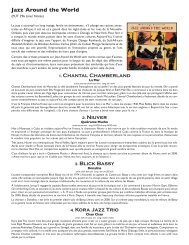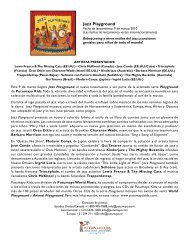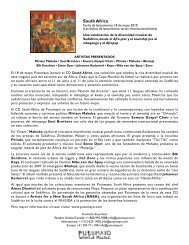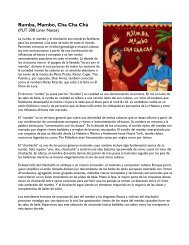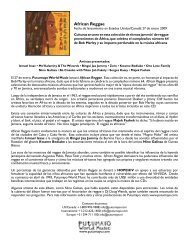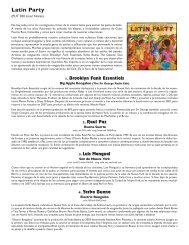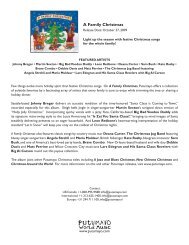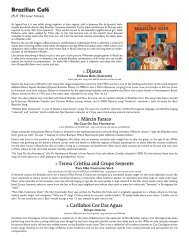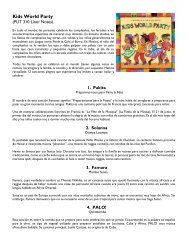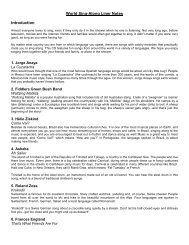You also want an ePaper? Increase the reach of your titles
YUMPU automatically turns print PDFs into web optimized ePapers that Google loves.
4. Burguitos<br />
Por Los Besos Que Me Das<br />
artist: boorg-EE-tohs song: por lohs beh-sohs kay may dahs<br />
Fernando Burgos, known as Burguitos, started his music career more than 25 years ago in Valencia, the capital and largest city in the Southeastern<br />
province of the same name. Also a talented actor and painter, Burguitos started his first band, Piedras en el Riñon, in the late 1970s. In the 80s, he<br />
formed the comedic salsa/pop group Combo Potombo, followed by the band Stilo Grafico. In the early 90s, Burgos renamed his band Burguitos<br />
and they often blend rumba, pop and world music flavors with humorous and satirical lyrics to create a fun, upbeat sound.<br />
“Por Los Besos Que Me Das” (For the Kisses that You Give Me), from the 2007 album of the same name, displays Burgos’ singer-songwriter skills.<br />
“For the kisses you give me / They make me lose my mind / It’s hard to know who I am / You hit the dance floor / I follow you with my eyes / I<br />
join your orbit / Let’s go to Pluto / And count the stars one by one.”<br />
5. Calima<br />
Lunita<br />
artist: kah-LEE-mah song: loo-NEE-tah<br />
Calima was founded in 2005 by Juanlu “El Canijo” Leprevost, who is best-known on the Spanish music scene as one of the co-founders of Ojos de<br />
Brujo. Calima’s debut album Azul earned raves from Spanish media and a Latin Grammy nomination for Best Flamenco Album.The band has performed at<br />
many important festivals across Europe and is fast developing a following for its hip, jazzy and soulful rumba flamenco sound.<br />
Calima’s second album, Tierra, was released in 2009 and featured this song,“Lunita” (Little Moon). Its musical vibe is similar in spirit to the Ojos de<br />
Brujo style, although with more jazz fusion influences.The song tells of the pain of unrequited love.“Yesterday I spoke to the moon / I took a walk<br />
with her / She told me of her happiness / And also her suffering / She’s in love with the sun / How it hurts, love.”<br />
6. Gossos featuring Dani Macaco<br />
Corren<br />
artist: goh-sohs featuring dah-nee mah-KAH-koh song: koh-ren<br />
Gossos is one of the most popular Catalonian rock groups, having built a faithful fan base since they got their start in the early 90s. Formed in<br />
Manresa, a small city in the heart of Catalonia, the band began with an acoustic sound and over the years has become increasingly<br />
electrified and harder-edged. They have released nine studio albums so far and their most recent, 2007’s Oxigen, received rave reviews and won<br />
numerous awards.<br />
Part of the album’s success surely comes from the catchy appeal of the love song “Corren” (Run), which features popular Barcelona singer Dani<br />
Macaco on guest vocals. “It’s late, I don’t know what time it is / But it’s been dark for a while / It’s easy to see that you are not here / I want to<br />
run, run down the streets.”<br />
7. El Combolinga<br />
Cumbia Caimanera<br />
artist: el kom-boh-LEEN-gah song: KOOM-bee-ya kye-mah-NEH-rah<br />
Founded nearly thirteen years ago in Madrid, El Combolinga’s guiding philosophy is “mestizaje,” or mixture, and this is reflected in their eclectic range<br />
of influences. Flamenco, reggae, rock, Afro-Cuban music, jazz, ska, African grooves — it all makes an appearance in the El Combolinga sound.The group<br />
has released five albums so far and their many concert appearances include touring the world alongside Bebe, one of Spain’s fastest rising stars.<br />
El Combolinga’s latest album, Mira Que Bien, was released in 2008 and includes this electrified twist on a traditional Colombian cumbia. On<br />
“Cumbia Caimanera” (Caiman Cumbia), the group sings,“From the other side of the river, where there are no streetlights / Fountains are dry and<br />
we don’t put foot to ball / That’s where we the caimans live / Without a job or glamour / We have big mouths and our eyes are looking south /<br />
That’s why we sing looking towards the south.”<br />
8. Uxía<br />
Danza Ritual<br />
artist: oosh-EE-ah song: dahn-sah ree-too-ahl<br />
Uxía is one of Galicia’s most respected and internationally acclaimed singers.The province borders Portugal and its regional language, Gallego, is<br />
closely related to Portuguese. As a result, Uxía has long felt a kinship with Portuguese culture.<br />
Uxía recorded her first solo album in 1986 and was a member of the seminal Galician folk revival band Na Lua until she left in 1991 to focus on<br />
her own work. In 1997, she recorded the album La Sal de la Vida alongside Spanish singer María Salgado and Sudanese singer Rasha. Over the years,<br />
Uxía has explored ways in which to connect her Galician roots with the traditions of other cultures both near and far.<br />
“You are still the spider / That spins my fate,” Uxía sings on “Danza Ritual” (Ritual Dance),“And together we shall dance / A ritual, creole and impure<br />
dance.”<br />
9. Xabier Lete<br />
San Martin, Azken Larrosa<br />
artist: hah-byer leh-teh song: san mar-TEEN ahz-kehn lah-ROH-sah<br />
The Basque Country is an “historic nationality” that spans the Pyrenees Mountains between Spain and France. Born in 1944 in the Basque village of<br />
Oyarzun (Oiartzun), Xabier Lete is one of his region’s most beloved singer-songwriters. Proud of his Basque heritage, Lete’s writing often addresses<br />
the region’s struggle to maintain its unique culture.




